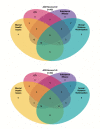Characterising a syndemic among black women at risk for HIV: the role of sociostructural inequity and adverse childhood experiences
- PMID: 35595503
- PMCID: PMC9887352
- DOI: 10.1136/sextrans-2021-055224
Characterising a syndemic among black women at risk for HIV: the role of sociostructural inequity and adverse childhood experiences
Abstract
Objectives Black women disproportionately experience STIs (including HIV/AIDS), gender-based violence, substance misuse and mental health conditions. Addressing a gap in syndemic research, we characterised comorbidity overlap within the context of sociostructural inequities and adverse childhood experiences (ACEs) among black women in Baltimore, Maryland. Methods Between 2015 and 2018, black women (n=305) were recruited from STI clinics in Baltimore, Maryland. Among those with complete survey data (n=230), we conducted a latent class analysis to differentiate women based on their profile of the following syndemic comorbidities: STIs, adult sexual victimisation, substance misuse and mental health disorders. We then examined the association between ACEs and syndemic latent class membership. Results Thirty-three percent of women experienced three to nine ACEs before age 18 years, and 44% reported four to six comorbidities. The two-class latent class solution demonstrated the best fit model, and women were categorised in either class 1 (past-year STI; 59%) or class 2 (syndemic comorbidities; 41%). Women in class 2 were more likely to report unstable housing (10% vs 3%) and identify as bisexual/gay (22% vs 10%) than women in class 1. ACEs were significantly associated with an increased likelihood of class 2 membership. Conclusions This study reinforces the importance of screening for ACEs and offering trauma-informed, integrated care for black women with syndemic comorbidities. It also highlights the critical nature of tailoring interventions to improve sociostructural equity, preventing and reducing syndemic development.
Keywords: genital diseases, female; race factors; sexual and gender minorities.
© Author(s) (or their employer(s)) 2023. Re-use permitted under CC BY-NC. No commercial re-use. See rights and permissions. Published by BMJ.
Conflict of interest statement
Competing interests: None declared.
Figures
References
-
- Centers for Disease Control and Prevention . Hiv surveillance report, 2018 (Preliminary), 2019.
-
- Centers for Disease Control and Prevention . Sexually transmitted disease surveillance 2017, 2018. Available: https://www.cdc.gov/std/stats17/2017-STD-Surveillance-Report_CDC-clearan...
-
- Smith SG, Basile KC, Gilbert LK. National intimate partner and sexual violence survey (NISVS): 2010-2012 state report, 2017.
-
- Anne Lown E, Nayak MB, Korcha RA, et al. . Child physical and sexual abuse: a comprehensive look at alcohol consumption patterns, consequences, and dependence from the National alcohol survey. Alcoholism: Clinical and Experimental Research 2011;35:317–25. 10.1111/j.1530-0277.2010.01347.x - DOI - PMC - PubMed
-
- Niolon PH, Kearns M, Dills J. Preventing intimate partner violence across the lifespan: a technical package of programs, policies, and practices, GNCfIPaC, editor. Atlanta: Centers for Disease Control and Prevention, 2017.
Publication types
MeSH terms
Grants and funding
LinkOut - more resources
Full Text Sources
Medical
Miscellaneous


